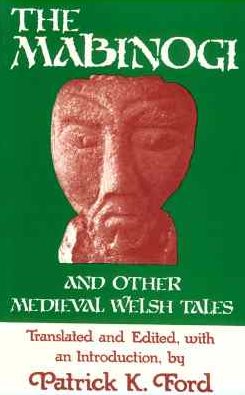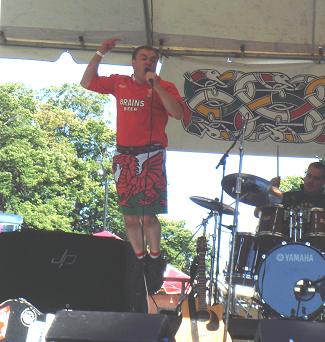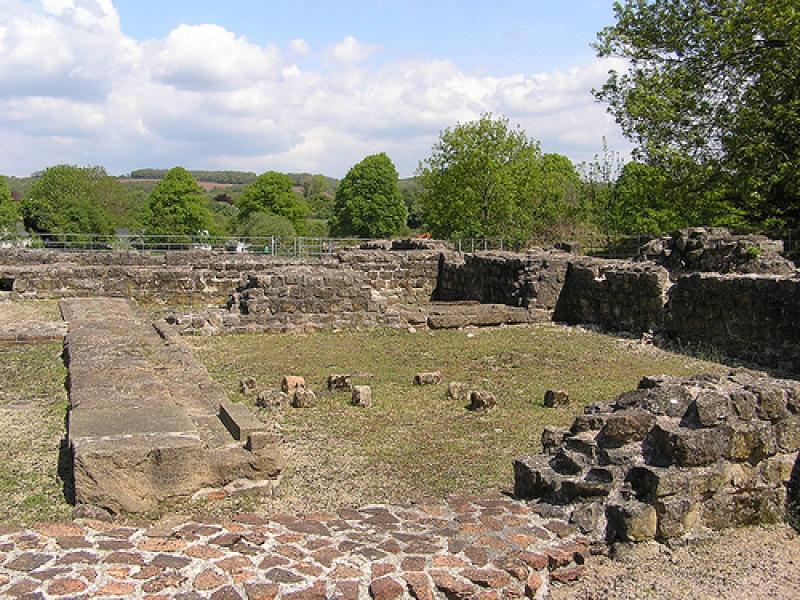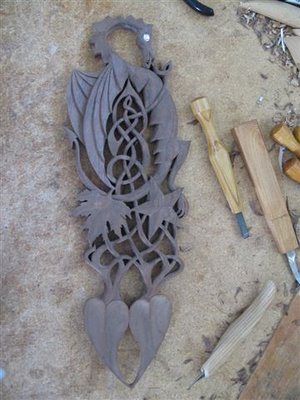Blogs
David Western & Laura Gorun's Left Coast Eisteddfod Lovespoon Blog, 22 April 2010, "The Middle"
By gaabi, 2010-05-20
Well, after having a really good, hard look at the new knotwork, I am in agreement with Laura that it needs to come down a bit, so I am going to have a bash at putting it just above the dragon and getting rid of the circle idea.
 I think if I can fatten up some of the knotwork just above the dragon's head, it will give some visual weight to the area and will let me tie the knot in a bit more smoothly.
I think if I can fatten up some of the knotwork just above the dragon's head, it will give some visual weight to the area and will let me tie the knot in a bit more smoothly.With the knotwork moved, there seems to be a 'tapering' feeling to the flow of the overall design, so I have widened the top area with the eagle a bit more and am tying the knotwork through. My hope is that we can surround the frame with the eagle and the knotwork and give things more of a three dimensional feel. It will make for some nasty carving problems, but should look pretty smart if we can pull it off!

After looking at this newest outline for a while, I am feeling that it is a bit stubby and too short at the top.
 I have opted to paste a couple of photocopies together to see if lengthening the top section helps things at all. Although it feels a bit empty and airy through the top section now, I think that the overall form of the design is very close to right now and that Laura will be able to fill in this area with some of her lovely vine or floral ideas.
I have opted to paste a couple of photocopies together to see if lengthening the top section helps things at all. Although it feels a bit empty and airy through the top section now, I think that the overall form of the design is very close to right now and that Laura will be able to fill in this area with some of her lovely vine or floral ideas.In the meantime, a quick reminder that you can win the finished spoon simply by donating to the Left Coast Eisteddfod. Every dollar you donate equals a chance at winning, so more dollars equals more chances!! Please consider supporting this worthwhile event and helping to further Welsh cultural events in North America!
Dave
apply for one of their cards. Sorry I let her through but still shes the first spammer weve missed in over a year so its not a bad record. I'll be more careful in future....promise:)
I should add that the site she is spamming is listed at the ripoff report website here: -
RipoffReport: EMarket Research, Consumer Incentive Promotions ...
and theres much more in a similar vein here:-http://www.google.com/#hl=en&source=hp&q=consumerincentivepromotions.com&btnG=Google+Search&aq=f&aqi=&aql=&oq=&gs_rfai=&fp=676b7c10d9dd9bf1
- Hi,
We are two young Welsh guys hoping to make a difference to our localcommunity and local business community. We hope to set up a socialenterprise to help educate and facilitate change to a greener way ofdisposing of waste and other environmental issues. In order to fund ouraims we have set up a waste management company that will put theenvironment above profit. We understand you are not in the UK but willappreciate anything you can do to help our cause, every little helpsright?
We have entered Barclay's take one small step competition in the hopeof winning funding to get us started and hope you can help us try togain support in any way you can.
To vote for us please follow
https://www.takeonesmallstep.co.uk/Entry/View/2258
And enter the code and click support this idea at the top right of screen.
If you'd like to follow our progress at facebook or our webpage please find the links below.
Thanks for your support.
Russell.
http://www.facebook.com/?ref=home# !/pages/Blackwood-United-Kingdom/Rocket-Recycling-LTD/124865177539382?ref=ts
http://rocketrecycling.net/
- Website:
- http://rocketrecycling.net
- What is your interest in or connection to Wales?
- I'm Welsh
| Not all Mabinogion's are created equal. This version has not only the four branches, but the Four Independent Tales, The Three Romances. Result? None are done as well as could be leaving much to be desired. Redemption, that it is in clear English and readable. Celtic mythology, Arthurian romance, and an intriguing interpretation of British history--these are just some of the themes embraced by the anonymous authors of the eleven tales that make up the Welsh medieval masterpiece known as the Mabinogion . Set in dual realms of the forests and valleys of Wales and the shadowy otherworld, the tales are filled by a dreamlike atmosphere. They tell of Gwydion the shape-shifter, who can create a woman out of flowers; of Math the magician whose feet must lie in the lap of a virgin; of hanging a pregnant mouse and hunting a magical boar. Dragons, witches, and giants live alongside kings and heroes, and quests of honor, revenge, and love are set against the backdrop of a country struggling to retain its independence. King Arthur's court provides the backdrop to tales such as "How Culhwch Won Olwen", in which a young man must complete many tasks before he can marry a giant's daughter. The work is divided into 11 disparate tales. Only the four of the first sections are explicitly "Branches of the Mabinogi," or stories of a youth. The youth is, according to a tradition followed by Gwyn Jones in her introduction, is Pryderi, the son of a Welsh King, Pwyll. Paperback: 272 pages Rating: 3 & a half Stars. Review by Bill Tillman |
| Patrick Ford has given us a college level version of the Mabinogion with a great many notes explaining the background and hard parts of the translation. A very worthwhile version to have in your library. First, "The Four Branches of the Mabinogi," from which the collective title was derived, consisting of "Pwyll, Prince of Dyved," Branwen Daughter of Llyr," "Manawydan Son of Llyr," and "Math Son of Mathonwy." These begin with a story about the conception and birth of Pwyll's son, Pryderi, whose death is one of the early events in the "Fourth Branch," and concern a variety of heroes, and what are clearly rationalized gods. (Evangeline Walton turned each of the "Four Branches" into a novel; and other writers have done versions of one or another of them.) Second, there are two "native tales," "The Dream of Maxen Wledig" and "The Story of Lludd and Lleuelys," about Roman ("historical") and pre-Roman ("mythical") Britain as imagined by the medieval Welsh. The 'Lludd" text, as we have it, actually belongs to the "Chronicle" tradition launched by Geoffrey of Monmouth's supposed translation from an "ancient British book." (Which, if any part of it ever had any existence, was NOT the "Mabinogion.") The name of Lludd seems to be Welsh variant of a Celtic divine name, "Nuada" in Irish, "Nodens" in old British inscriptions, and "Nudd" in other Welsh sources; the variation seems to be due to assimilation to his epithet, Llaw Eraint, "Silver Hand," which is explained in the Irish tale of how the physician of the Gods made new hand for Nuada Argatlam." (H.P. Lovecraft picked up "Nodens" for the Cthulhu Mythos, a use which is unrelated; but Tolkien, whose hero Beren also lost a hand, actually wrote an early article on the Nodens inscriptions, and the apparent offerings of metal hands.) He may be behind King Lud, the supposed eponym of London. As Ford points out, Lleuellys, usually given as Llevellys, and also modernized as Llefellys, clearly should be read as Lleu-ellys, and recognized as a version of the god Lugh: the name Lleu is also used for a character in the Fourth Branch of the Mabinogi. "Maxen," in which a Roman Emperor seeks as his wife a princess seen in a dream, seems to reflect an even more garbled version of a story known to Geoffrey, compounding several real people, including Helen, the mother of the Emperor Constantine. She was, in a medieval confusion compounding an honest mistake with local patriotism, believed to be British, and identified with "Elen of the Hosts." Ford drops this, as it seems to contain a rather high proportion of medieval hagiography and romance, and a very low proportion of archaic Welsh tradition. Third are two Arthurian stories in native Welsh mode. "Culhwch and Olwen," is an elaborate quest, dragging in, at least by name, most of the gods and heroes traceable in Welsh material, and some of their Irish cousins into the bargain, mostly as part of Arthur's court. "The Dream of Rhonabwy" is a visionary encounter with Arthur and his warriors (and anything else I could say would probably be controversial); a fascinating text, which, after a very grittily realistic opening, almost boasts of its authentically dreamlike obscurity. It breaks off in a manner most modern readers will find unsatisfactory -- and its arbitrary nature may have been part of the point. Ford does not include it; a pity, but it is probably the least readable part of the collection. Fourthly however Ford does not translate the three "Romances," "Owain" (otherwise known as "The Lady of the Fountain"), "Peredur son of Evrawc," and "Gereint the Son of Erbin," the first and last of which are clearly versions of Chretien de Troyes' Old French Arthurian Romances, "Yvain" and "Erec," while the second is related in a more complex manner to his unfinished and problematic "Perceval le Gallois." These seem to illustrate Celtic materials going out into wider European society, and then flowing back into Wales to enrich (and confuse) the native heroic and mythic tradition with ideas of chivalry. The version of "Taliesin," based, as noted earlier, on the text Ford had re-edited from manuscripts, is restored to its two-story version, as "The Tale of Gwion Bach" and "The Tale of Taliesin," and includes reliable versions of the poems attributed to the variously-reborn hero. Again, there was a real Taliesin, a dark-age Bard, according to Welsh tradition; but these poems, like the stories, are pretty much independent of anything he may have actually composed. But they *may* reflect some very archaic ideas about the magical nature of poetry, which were old when the real Taliesin was alive. Ford included as an appendix a translation of the notoriously difficult "Cad Goddeu," or "Battle of the Trees." Ford doesn't claim to understand its "real meaning," if any, only what it actually says, and it is very nice to have it. Paperback: 205 pages Rating: 4 Stars Review by Bill Tillman
|
New head chef arrives at Tyn y Cornel
The prestigious Tyn y Cornel Hotel, sitting on Talyllyn lake in the Snowdonia National Park, has appointed a new head chef.
Thomas Mansfield, 31, brings a wealth of first class experience to the hotel.
A proud Welshman, originally from Cardiff, Mr Mansfields arrival follows quickly on the heels of the appointment of Phil Thomas as the new general manager of a hotel which occupies what is arguably the best location in Wales, just below majestic Cader Idris.
Mr Mansfield said: Im delighted to be joining the new team at Tyn y Cornel.
Its a very exciting time at the hotel and Im looking forward to working with the best local suppliers to compile a new a la carte menu as well as a lunch and dinner menu which will change daily.
I also intend to develop our great value lounge and bar menu, which will feature many old favourites as well as some hearty new dishes.
Mr Mansfields CV is extensive.
He has worked at the Five Star St Davids Hotel in Cardiff Bay and the Newbridge Inn in Monmouthshire, a venue famously owned by Radio 2 DJ and TV personality Chris Evans.
He has also worked at the Three AA Rosette La Gousse d'Ail restaurant in Oxford.
Mr Mansfield has worked as head chef at the renowned Bullys restaurant in Cardiff and at the exclusive Park House members club in the city.
He acted as chef consultant to Llanerch Vineyard, often working alongside celebrity chefs Martin Blunos and Waless own Hywel Jones.
Mr Mansfield has also spent time as head chef aboard the $80million super yacht Lady Ann, cooking for a range of celebrities and royals.
|
Mike: "Well Cardiff, which is my home city has reached a European Cup Final for the first time since 1996. It could be the first time a Welsh team has won a European wide Rugby cup. Three members of the band have cheered on "The Blues" at matches this year so it seemed right to support them for the final in France. "Allez Les Blues" is the result and is the official song of the Cardiff Blues Supporters Club. (In case you wondered, the places listed in the song are all the clubs within the Blues region) The supporters Club has asked for copies of the song to play at various events as well as on the plane going over!" If you cant physically be on the plane on May 23rd you can be there in spirit with a sixpack of S.A. and a copy of Allez Les Blues . The Blues will be playing Toulon at Marseilles on May 23rd in a bid to win the Amlin Challenge Cup and become the first Welsh region to to win a European competition. ( read more here ) We seized the opportunity to ask Mike about he bands future recording and tour plans:- Mike: "Yeah We've got "Mae Yma Dreigiau" coming out soon (Welsh Language CD bonus in English) Then in the Autumn an album of Rugby songs. We're playing in Spain in the summer hope fully Wales and Italy in the Autumn." Heres wishing every success to the Blues in Marseilles on the 23rd and to Here Be Dragons, one of Wales finest Celtic bands.
|
Within These Walls by Patric Morgan
It was Julius Caesar who made the first moves to invade Britain, when in 55BC, he sent out a small expedition to explore the possibility of trade and wealth in this distant and legendary island. It wasnt until nearly one hundred years later however, in 43AD, that the Romans really well and truly got a grip on the island. Claudius sent 40,000 men to the UK, which provided the foundation for Roman rule for the following four centuries. The UK was never to be the same again. Roads criss-crossed the island, cutting through forests and linking habitable places together for the first time.
Towns and cities were also constructed, some of which can still be seen today. This can perhaps, best be demonstrated in the sleepy Welsh village of Caerwent, about 25 miles east of the Welsh capital, Cardiff.
Under its subtle and genteel meadows lie some of the best kept Roman ruins in Europe. Founded in 75, this was once a market town known as Venta Silurum. The Romans had reached the site in 47, by which time they had most of southern and central England under their control. But the Welsh proved a tougher nut to crack, the area being mountainous and ruled by four tribes. South East Wales was ruled over by the Silures tribe, described as having swarthy faces and curly hair. The Silures inflicted the greatest ever defeat on the Romans in the UK in 52, when they took apart a Roman legion and the scalp of the Roman general and statesman Scapula. In fact, it took the Romans over thirty years to bring the unruly Welsh to heed when Romanisation could begin to take place. The Romans had for years been using a clever trick of turning enemies into friends, usually by befriending the local tribe chief and bribing them with carnal pleasures. The Welsh it appears, were a little wiser to them.
By 200, the city had acquired a network of streets, with some twenty blocks and main public buildings. The population of the 44 acre site is thought to have been around 3,000 at its height. By 115, a Basilica Forum had been created, suggesting some form of self-government. Despite being one of the smallest Roman settlements in the UK, local legionary veterans were attracted to settle here thanks to its wealth.
Today, the village is a peaceful and unassuming place. Its layers of history can be found in the largely unexcavated fields that are encased in stone. The foundations of the city that once sat here lie largely untouched and guarded by grimacing stone walls, some of which rise over 5 meters. Small flowers now bud from them while farm animals chew at the cud, seemingly unaware of the history beneath their hooves.
The town itself is a simple affair. A main street houses a smattering of public buildings a church, a Post Office and the Coach and Horses Inn. Locals now gather here for their feasts at midday. Scribed on the blackboards are Todays Specials: Chicken Curry, Pie and Mashed Potato with gravy.
Two more fish and chips please. says the lady waiting at the bar. Its obvious from the casual slacks that shes wearing that shes expecting a hearty meal.
The other pub around the corner, the Northgate Inn, makes the most of its historic gardens. Excavations at Caerwent have revealed remains and everyday objects from the post-Roman period. Metalwork, including elaborate penannular brooches and fastening pins, have been dated to the 5th-7th centuries. These days, a blackboard shows sign of competition. First to 13 it reads. Game and winner unknown.
Down at the Post Office, a small red post box sits squat in the wall. Its GR emblem reminding us that Elizabeth has not been reigning forever. Lambs with their mothers now frolic and graze in the grounds of the Basilica Forum.
Despite the thousands of feet that have once marched upon Caerwent, the Romans havent entirely left yet. Their legacy is reflected in the names of streets and buildings that make up this small but uniquely historic village.
Getting there:
By Rail: Nearby railway stations: Chepstow, Severn Tunnel Junction (bus connection to Caerwent)
By Car: Take the A48 eastwards from Newport or the A48 westwards from Chepstow.
Nearest Airport: Cardiff Wales (35 miles away)
Accommodation:
Coach and Horses Inn http://www.caerwent-coachandhorses.co.uk/
Nearby Attractions:
Historic Roman town of Caerleon
Celtic Manor, host to the 2010 Ryder Cup
|
The Left Coast Eisteddfod will be held in Portland in the first week of October this year. Events cost money and the Eisteddod is no exception. The Meriwether Lewis Memorial Eisteddfod Foundation is a 501c3 non-profit which raises funds for this and other similar events. Our objective is to hold an annual Eisteddfod on the US West Coast with live competitions in poetry, story telling and other traditional ( and not so traditional ) bardic arts. Eventually we would like to inauguarate recognised Bardic chairs for some of these competition categories. Lovespoons are a traditional Welsh folk art. David Western and Laura Gorun are lovespoon carvers who have very generously donated their time to create a one-of-a-kind masterpiece in support of the Left Coast Eisteddfod. Every dollar you give buys you a ticket and a chance to win the spoon. Five dollars, equals five tickets, fifty dollars equals fifty tickets and fifty chances to win. This is David's second year of creation in support of this event and we are very grateful for his and Laura's generosity in sharing their work with us all. For a chance to win their spoon this year, click on the 'Donate' button in the right-hand column on any page on the AmeriCymru website and be sure to note that your payment is for the lovespoon. You do not need to be a member of AmeriCymru or logged into the site to do this and everyone will receive a PayPal receipt and an email of acknowledgement from the Eisteddfod organisers.Last years spoon, uniquely hand-crafted and valued at around $1000 is pictured on this page.
If you want to follow a step-by step account of the design and creation of this years spoon go to this blog:- http://davidwestern.blogspot.com/ The prize draw will take place at our 'Last Bard Standing' event in Portland on October 8th. More information about the event can be found here:- http://www.facebook.com/AmeriCymru?v=app_2344061033#!/event.php?eid=110551428972706&index=1 If you wish to enter the draw click on the 'Donate' button in the right hand column on this page Remember...every dollar you spend equals one extra chance to win this unique work of art. We are not necessarily looking for large sums. If everybody here gave $5 it would contribute enormously toward the success of the event. If you decide to contribute, we wish you pob lwc/best of luck in the draw.
Bendithion Ceri Shaw/Gaabriel Becket ----------------------------------------------------------------------------------------- Anyone wanting further information about attending, sponsoring, competing or anything else to do with the Eisteddfod schould contact us at americymru@gmail.com . We aim to answer all enquiries personally and in a timely manner.
|












